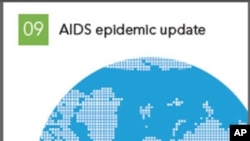A South African professor who’s followed HIV/AIDS trends for about 30 years sees both good and bad in the latest statistics.
Tuesday, UNAIDS issued the 2009 AIDS Epidemic Update, which says approximately 33.4 million people were living with HIV in 2008. It’s also estimated there were 2.7 million new infections that year and two million deaths. The report also says an eight-year trend shows that new HIV infections are down by 17 percent, with most of the improvement seen in sub-Saharan Africa.
Professor Alan Whiteside is director of health economics and HIV/AIDS research at the University of KwaZulu-Natal in Durban and co-author, along with Professor Tony Barnett, of the book AIDS in the 21st Century.
Two impressions
“The first one is that it’s good news because the HIV numbers are leveling out. And that can only be satisfying for those of us who watched them rise for nearly 30 years,” he says.
However, he says he finds it “frustrating” that UNAIDS does not easily provide year-on-year data about the epidemic.
“When you look at the first edition,” he says, “I think we were slightly wrong in a number of places. We thought that the epidemic would be more serious in Asia than it has been. In Russia and the former Soviet countries it hasn’t moved out of the drug using population to the extent we thought it was going to. There are parts of Africa where AIDS hasn’t taken off or where it’s become less of an issue.”
Those areas include Uganda and Kenya, although he says if the same prevalence rates occurred in the United States they would be considered “catastrophic.”
“The really serious problem is in southern Africa. For example, in Swaziland, approximately one in two women of child bearing age is currently infected. And those women will need treatment or will die,” he says.
Southern Africa has been called the epicenter of the HIV/AIDS pandemic and the problems there have been highlighted for years. So, why does HIV/AIDS remain such a big problem there?
“I think the reasons for the seriousness of the epidemic,” he says, “are around the social and economic drivers. Gender relations are very critical and again, if you look at southern Africa, you have to say that the way gender relations are operating there is very bleak.”
Whiteside and Barnett have called for empowering women by ensuring equality with men on both the social and economic levels. Studies have shown many women fear to say no to sexual relations with their husbands, even if they know the men are HIV positive.
Stopping the spread of HIV
Despite treatment and prevention programs, the AIDS virus continues to spread.
“A vaccine is absolutely critical,” he says, “given that the epidemic centers around sex and socialization, I don’t believe that we would ever get a handle on it without a vaccine.”
Many humanitarian groups say the global economic slowdown is having an effect on efforts to control the epidemic. Whiteside agrees.
“Over the last few years, rolling out treatment across the world has been extremely successful. But what we’re starting to hear is that new cohorts of people are not being put on treatment at the same speed because we’ve come to the limit. And the limits are both financial and infrastructure. And when I say infrastructure I don’t just mean the hospital spaces, but I mean the staff who can administer the drugs,” he says.
He says the recession raises serious questions about how to go forward, including how resources will be allocated. He asks, “Will donors take on the responsibility of treating people for the rest of their lives and putting many millions of new cohorts of people onto this treatment?”
Whiteside admits he doesn’t have the answers to these questions, but adds, “They do need to be posed.”





